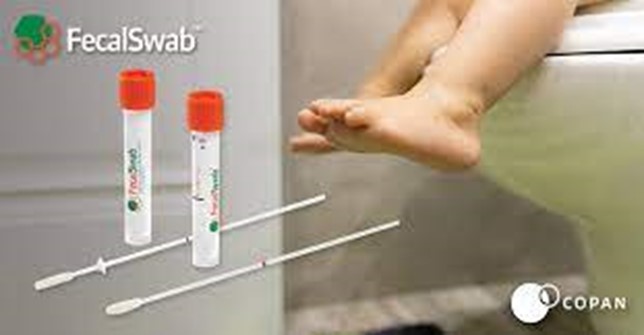A nurse is planning to collect a stool specimen from an infant to check for the presence of ova and parasites. Which of the following actions should the nurse plan to take?
Obtain the specimen by swabbing the infant's rectum using a sterile culture swab.
Place a urine collection device on the infant until the specimen is obtained.
Transfer the specimen to the collection container using povidone-iodine-soaked gauze.
Maintain the specimen at room temperature after collection until it is transferred to the lab.
The Correct Answer is A
Choice A rationale:
Obtain the specimen by swabbing the infant's rectum using a sterile culture swab. This is the correct choice. When collecting a stool specimen from an infant, the rectal swab method is commonly used. A sterile culture swab helps prevent contamination and ensures accurate results for detecting the presence of ova and parasites in the stool.

Choice B rationale:
Place a urine collection device on the infant until the specimen is obtained. This choice is not appropriate for collecting a stool specimen. A urine collection device is used for collecting urine, not stool. The specimen for ova and parasites needs to be taken directly from the rectum or diaper to accurately identify any infestations.
Choice C rationale:
Transfer the specimen to the collection container using povidone-iodine-soaked gauze. While povidone-iodine is an antiseptic, it is not typically used to transfer stool specimens. Using a sterile swab or a clean, dry container is more suitable for collecting and transporting stool samples to the lab.
Choice D rationale:
Maintain the specimen at room temperature after collection until it is transferred to the lab. Stool specimens for ova and parasites usually require refrigeration to prevent the degradation and growth of potential pathogens. Room temperature might lead to the overgrowth of bacteria and parasites, affecting the accuracy of test results.
Nursing Test Bank
Naxlex Comprehensive Predictor Exams
Related Questions
Correct Answer is A
Explanation
Choice A rationale:
This response indicates an understanding of the teaching about celiac disease. Rice is a gluten-free grain, which makes rice pudding a suitable dessert option for a child with celiac disease. Gluten is a protein found in wheat, barley, and rye, and individuals with celiac disease need to avoid gluten-containing foods.
Choice B rationale:
Barley is a gluten-containing grain, and feeding a child a barley-based breakfast cereal is not appropriate for someone with celiac disease. Gluten-containing grains can trigger adverse reactions in individuals with celiac disease due to their inability to properly digest gluten.
Choice C rationale:
Rye bread contains gluten, and making sandwiches using rye bread is not a suitable choice for a child with celiac disease. Gluten-free bread options, typically made from rice, corn, or other gluten-free flour, should be chosen instead.
Choice D rationale:
Chocolate malt may contain ingredients that could potentially contain gluten, and it's not a safe snack option for a child with celiac disease. Individuals with celiac disease need to be cautious about hidden sources of gluten in processed foods.
Correct Answer is D
Explanation
Choice A rationale:
Gently lift the traction weights off the floor when repositioning the client. Rationale: This choice is not recommended in the care of a client in skeletal traction. Traction weights should never be lifted off the floor as they provide the necessary counter traction to align and immobilize the fractured bone. Lifting the weights could disrupt the traction and jeopardize the healing process.
Choice B rationale:
Reduce intake of foods containing fiber while nonambulatory. Rationale: While constipation can be a concern for clients in skeletal traction due to decreased mobility, reducing fiber intake is not the appropriate intervention. Adequate fiber intake is important to promote regular bowel movements and prevent constipation. Hydration and mobility exercises are more suitable approaches to manage constipation.
Choice C rationale:
Perform passive range-of-motion exercises to the affected extremity every 2 hours. Rationale: Passive range-of-motion exercises are important to maintain joint mobility and prevent muscle atrophy in a nonambulatory client. However, performing these exercises every 2 hours might be excessive and could cause unnecessary discomfort for the client. Range-of-motion exercises are usually done every 4 to 8 hours to strike a balance between maintaining joint health and providing rest.
Choice D rationale:
Apply protective padding to the end of the pin sites. Rationale: This is the correct choice. Applying protective padding to the end of the pin sites is crucial to prevent pressure ulcers and infection. The pin sites are potential entry points for bacteria, and protecting them helps reduce the risk of infection. Padding also prevents pressure on the skin and underlying tissues, reducing the potential for pressure injuries.
Whether you are a student looking to ace your exams or a practicing nurse seeking to enhance your expertise , our nursing education contents will empower you with the confidence and competence to make a difference in the lives of patients and become a respected leader in the healthcare field.
Visit Naxlex, invest in your future and unlock endless possibilities with our unparalleled nursing education contents today
Report Wrong Answer on the Current Question
Do you disagree with the answer? If yes, what is your expected answer? Explain.
Kindly be descriptive with the issue you are facing.
